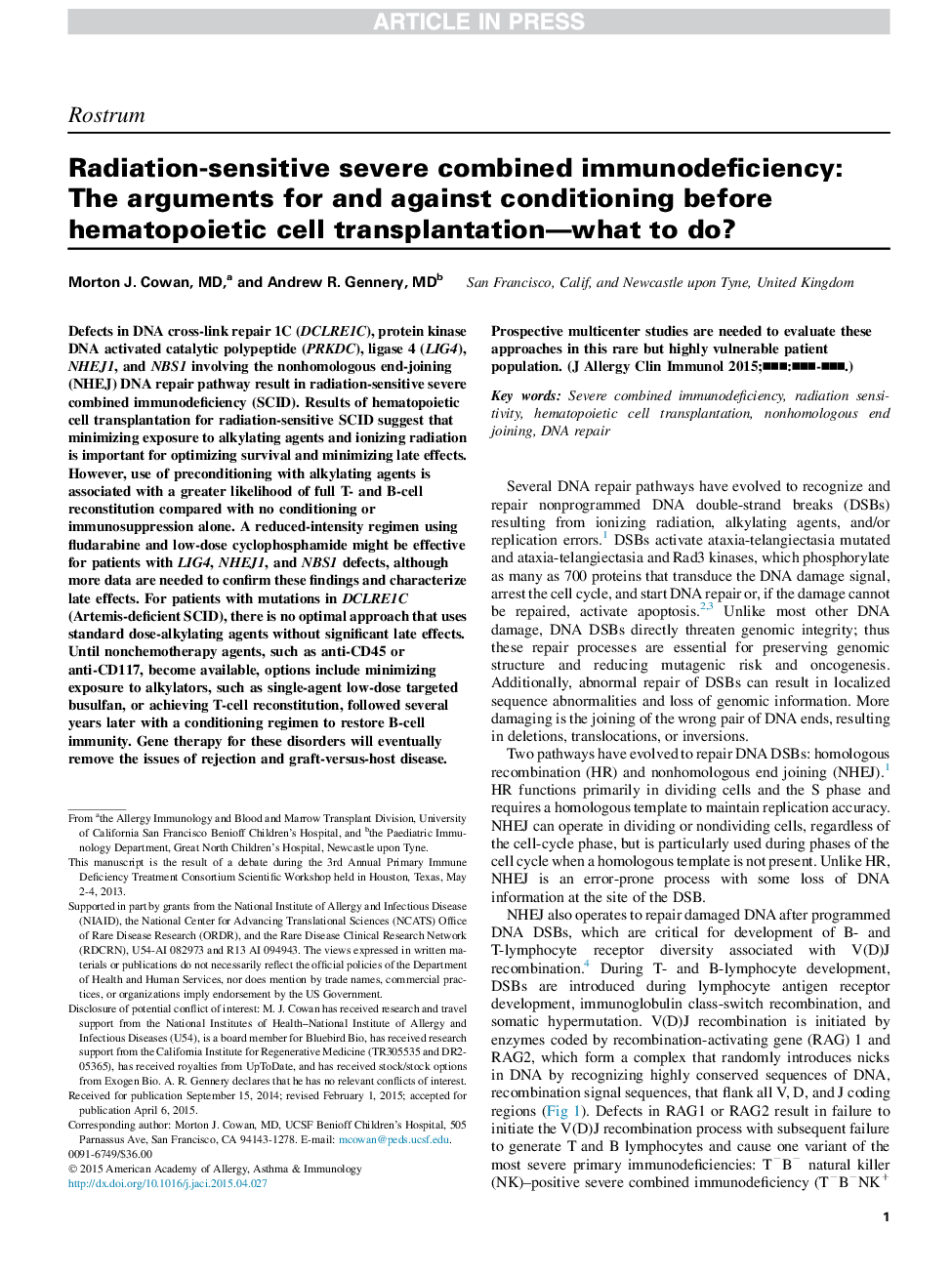| کد مقاله | کد نشریه | سال انتشار | مقاله انگلیسی | نسخه تمام متن |
|---|---|---|---|---|
| 6063216 | 1201849 | 2015 | 8 صفحه PDF | دانلود رایگان |
عنوان انگلیسی مقاله ISI
Radiation-sensitive severe combined immunodeficiency: The arguments for and against conditioning before hematopoietic cell transplantation-what to do?
ترجمه فارسی عنوان
کمبود ایمنی ترکیب شده حساس به تابش: آرگومان و برای پیشگیری قبل از پیوند سلول های خونگرم - چه کاری باید انجام شود؟
دانلود مقاله + سفارش ترجمه
دانلود مقاله ISI انگلیسی
رایگان برای ایرانیان
کلمات کلیدی
HSCDSBGvHDNHEJHCTATGSCIDTBIDNA-PKcsRICRAGnatural killer - (سلول های) کشنده طبیعیantithymocyte globulin - آنتیسموکسی گلوبولینTotal body irradiation - اشعه ماوراء بنفشGraft-versus-host disease - بیماری مرض در برابر میزبانDNA repair - ترمیم DNAReduced-intensity conditioning - تهویه با کاهش شدتMyeloablative conditioning - تهویه مطبوعRadiation sensitivity - حساسیت تابشHematopoietic stem cell - سلول بنیادی هماتوپوئیتdouble-strand break - شکست دو ردیفMAC - مکSCID, Severe combined immunodeficiency - نقص ایمنی مرکب شدیدHomologous recombination - نوترکیبی همولوگDNA-dependent protein kinase catalytic subunit - وابسته به DNA وابسته به پروتئین کیناز کاتالیزوریNonhomologous end joining - پیوستن به انتهای غیرخطیHematopoietic cell transplantation - پیوند مغز استخوانRecombination-Activating Gene - ژن فعال سازی مجدد ترکیب
موضوعات مرتبط
علوم زیستی و بیوفناوری
ایمنی شناسی و میکروب شناسی
ایمونولوژی
چکیده انگلیسی
Defects in DNA cross-link repair 1C (DCLRE1C), protein kinase DNA activated catalytic polypeptide (PRKDC), ligase 4 (LIG4), NHEJ1, and NBS1 involving the nonhomologous end-joining (NHEJ) DNA repair pathway result in radiation-sensitive severe combined immunodeficiency (SCID). Results of hematopoietic cell transplantation for radiation-sensitive SCID suggest that minimizing exposure to alkylating agents and ionizing radiation is important for optimizing survival and minimizing late effects. However, use of preconditioning with alkylating agents is associated with a greater likelihood of full T- and B-cell reconstitution compared with no conditioning or immunosuppression alone. AÂ reduced-intensity regimen using fludarabine and low-dose cyclophosphamide might be effective for patients with LIG4, NHEJ1, and NBS1 defects, although more data are needed to confirm these findings and characterize late effects. For patients with mutations in DCLRE1C (Artemis-deficient SCID), there is no optimal approach that uses standard dose-alkylating agents without significant late effects. Until nonchemotherapy agents, such as anti-CD45 or anti-CD117, become available, options include minimizing exposure to alkylators, such as single-agent low-dose targeted busulfan, or achieving T-cell reconstitution, followed several years later with a conditioning regimen to restore B-cell immunity. Gene therapy for these disorders will eventually remove the issues of rejection and graft-versus-host disease. Prospective multicenter studies are needed to evaluate these approaches in this rare but highly vulnerable patient population.
ناشر
Database: Elsevier - ScienceDirect (ساینس دایرکت)
Journal: Journal of Allergy and Clinical Immunology - Volume 136, Issue 5, November 2015, Pages 1178-1185
Journal: Journal of Allergy and Clinical Immunology - Volume 136, Issue 5, November 2015, Pages 1178-1185
نویسندگان
Morton J. MD, Andrew R. MD,
